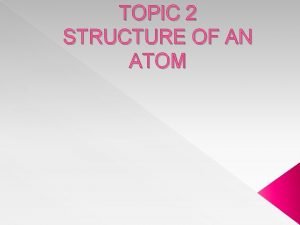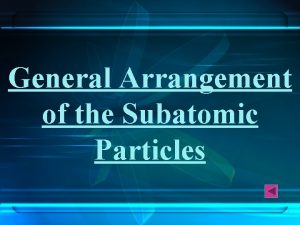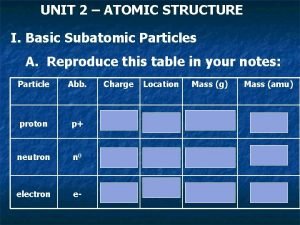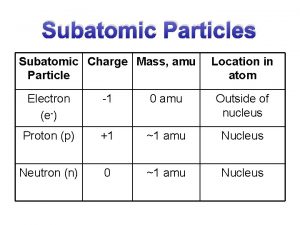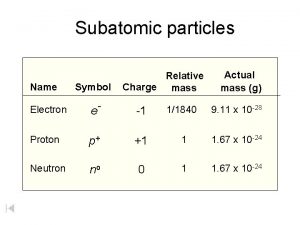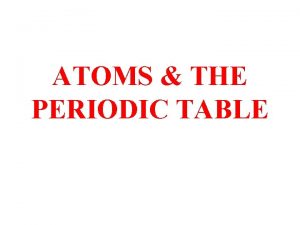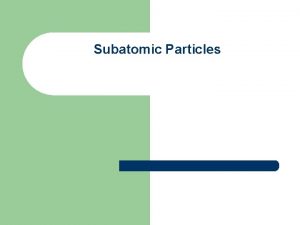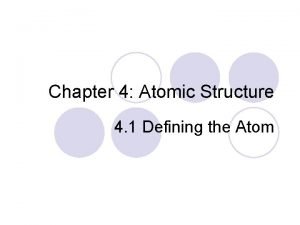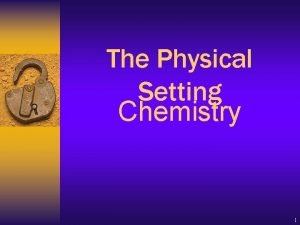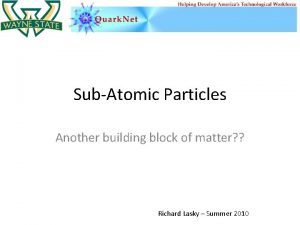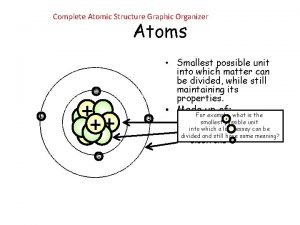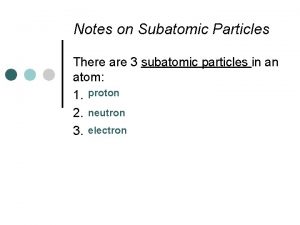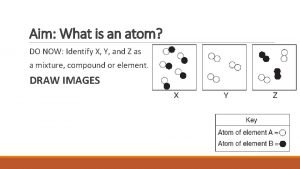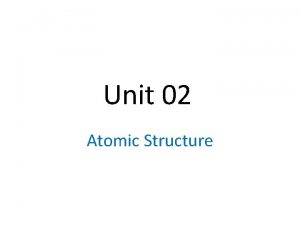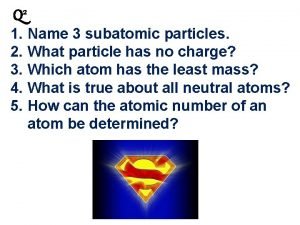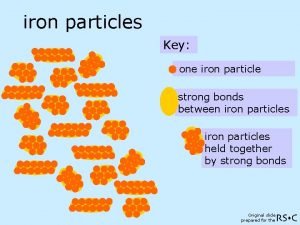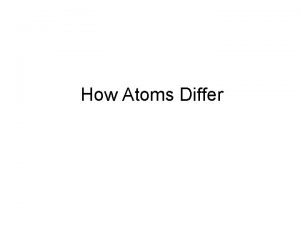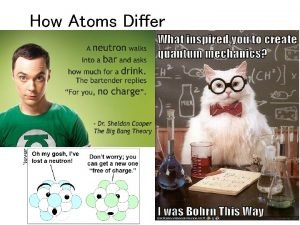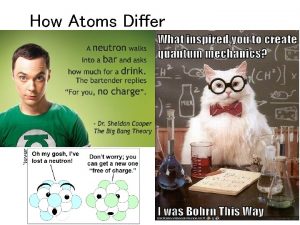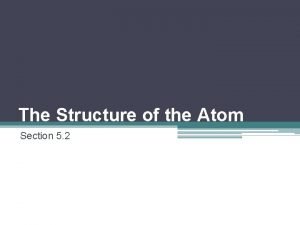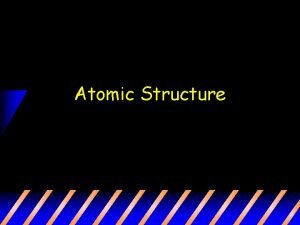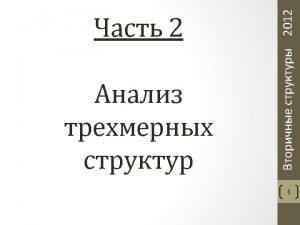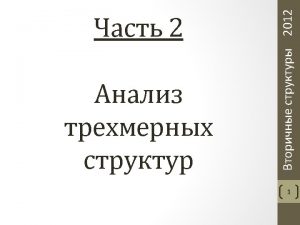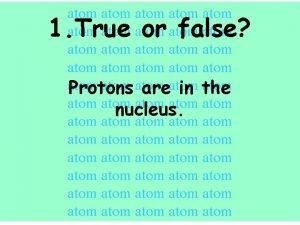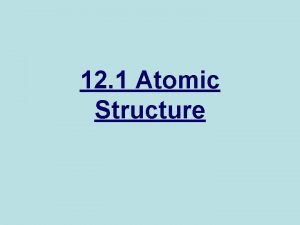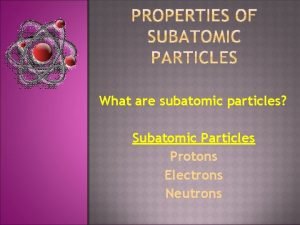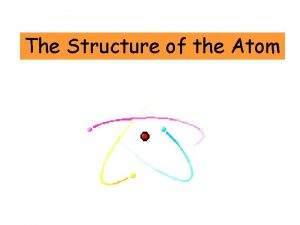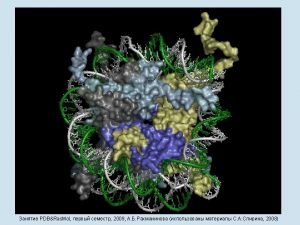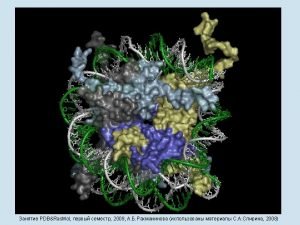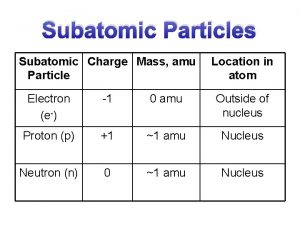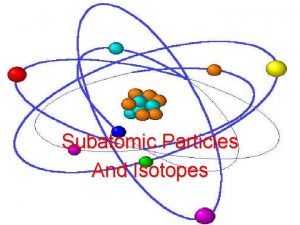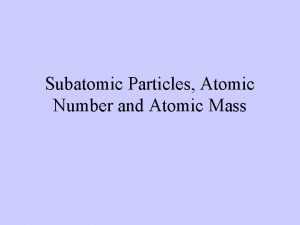TOPIC 2 STRUCTURE OF AN ATOM SUBATOMIC PARTICLES

TOPIC 2 STRUCTURE OF AN ATOM

SUBATOMIC PARTICLES Atoms are made up of three types of smaller particles, namely protons, neutrons and electrons. These particles are known as subatomic particles. SUBATOMIC PARTICLE SYMBOL RELATIVE MASS RELATIVE ELECTRIC CHARGE PROTON P 1 +1 NEUTRON n 1 0 ELECTRON e 0 (almost) -1

q. Protons and neutrons are found in the nucleus of an atom while electrons surround the nucleus.

SYMBOLS OF ELEMENTS Each element is given a name and a symbol. Some examples of elements and their symbols are shown below. ELEMENT SYMBOL Hydrogen H Sodium Na Helium He Magnesium Mg Lithium Li Aluminium Al Beryllium Be Silicon Si Boron B Phosphorus P Carbon C Sulphur S Nitrogen N Chlorine Cl

SYMBOLS OF ELEMENTS Nucleon number Proton number


Proton number = An elements is the number of protons in its atom. Since atoms are neutral, the proton number is also the number of electrons in the atom. Proton number = electron number Each elements has its own proton number.

Nucleon number The nucleon number is also known as the mass number. The relative mass of an atom is almost the same as its nucleon number. Protons and neutrons are collectively called nucleons because protons and neutrons occupy the nucleus.

Nucleon number: total number of protons and total number of neutrons in its atom. From definition, Nucleon number = number of proton + number of neutrons or Number of neutrons = nucleon number – number of proton

ISOTOPES Isotopes are atoms of the same element with the same number of protons but different numbers of neutrons. Isotopes of an element have the same: (a) number of protons in an atom. (b) number of electrons in an atom. (c) electron arrangement. (d) chemical properties because they have the same electron arrangement.

Isotopes of an element have different: (a) nucleon number. (b) number of neutrons in an atom. (c) physical properties (such as density, melting point and boiling point), though these different are very small. Eg: 3 He, 4 He, 12 C, 14 C, 235 U, and 239 U, respectively)

Atomic Structure Worksheet Fill in the blanks for the elements in this chart. For the purposes of this chart, round all atomic masses to the nearest whole number. Element lithium carbon chlorine silver lead calcium Number of Protons Neutrons Electrons Atomic Mass Atomic Number

ANSWER Element Number of Protons Number of Neutrons Number of Electrons Atomic Mass Atomic Number lithium 3 4 3 7 3 carbon 6 6 6 12 6 chlorine 17 18 17 35 17 silver 47 61 47 108 47 lead 82 125 82 207 82 calcium 20 20 20 40 20

ELECTRONIC STRUCTURE OF AN ATOM

Electron configuration v The electron configuration (electron arrangement) of an atom is the arrangement of electrons in shells (orbits) around the atom's nucleus.

Example SODIUM Proton number = 11 Electron configuration = 2. 8. 1

Valence electron The electrons in the last shell of an atom are known as valence electrons. They determine the chemical properties of the element. Electron configuration = 2. 8. 4 Valence electron = 4 Electron configuration = 2. 7 Valence electron = 7 Electron configuration = 2. 4 Valence electron = 4

DUPLET & OCTET Helium has a complete shell of 2 valence electrons or duplet condition. Similarly, neon and argon also have 8 valence electrons or the octet condition. These elements are monoatomic and are very stable gases. Helium 2 Neon 2. 8 Argon 2. 8. 8

Position in Periodic Table Number of shells = Period in Periodic Table Valence electron (1 and 2) = Group in Periodic Table Valence electron (3 – 8) = Valence electron + 10 = Group in P. Table eg: Valence electron =7 So, Group 17 1 8 2 SODIUM Proton number = 11 Electron configuration = 2. 8. 1 Position in Periodic Table Period: 3 Group : 1

Element Proton Number number of electrons Number of elements in shell Electron Number of arrangement valance 1 2 3 4 electrons Oxygen 8 8 2 6 2. 6 6 Fluorine 9 9 2 7 2. 7 7 Neon 10 10 2 8 2. 8 8 Sodium 11 11 2 8 1 2. 8. 1 1 Magnesium 12 12 2 8 2 2. 8. 2 2 Aluminium 13 13 2 8 3 2. 8. 3 3 Silicon 14 14 2 8 4 2. 8. 4 4

LETS TRY!! 1. Draw electron arrangement for element Na, Ar, Mg, Al, Cl, O, C, N. 2. State the valence electron for each elements 3. State the position in Periodic Table

THANK YOU…
- Slides: 22
